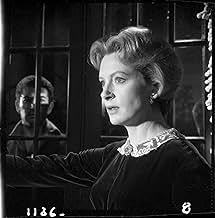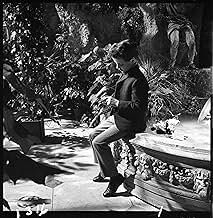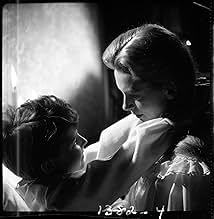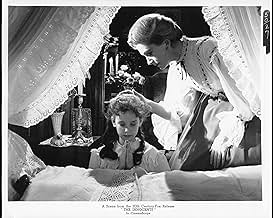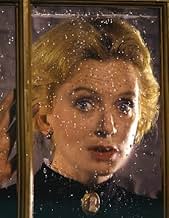Eine junge Erzieherin für zwei Kinder kommt zu der Überzeugung, dass es in Haus und Grundstück spukt.Eine junge Erzieherin für zwei Kinder kommt zu der Überzeugung, dass es in Haus und Grundstück spukt.Eine junge Erzieherin für zwei Kinder kommt zu der Überzeugung, dass es in Haus und Grundstück spukt.
- Nominiert für 2 BAFTA Awards
- 4 Gewinne & 5 Nominierungen insgesamt
Empfohlene Bewertungen
The title loads this gun a little differently than the original from the long short story (or novella) by Henry James--The Turn of the Screw. But Jack Clayton's version of the story gets at the point with great ambiguity--uncertainty is key, and the suspense is partly under pressure because we don't quite know which side to take.
I can't say more, of course, because even a hint of a hint will start a viewer off on the wrong foot. But know that The Innocents is vigorously filmed in widescreen black and white, that Deborah Kerr, always a cool actress, is perfectly cool here (some might just say British, but she has no Julie Andrews in her governessing, and no Elizabeth Taylor in her at all). The two kids are both rather poised and charming as well as chilling, the boy especially intriguing for his precociousness (and preciousness). We empathize with all three equally, and yet, as you see, you can't quite see the events from their three pairs of eyes equally. Something is wrong, and you wait to see what, and how it will be revealed.
If it ever is. One of the brilliant things about Henry James is how you finish one of his books (the novels are better than the stories for this, I think) knowing what has happened but not knowing completely why. I mean, it all makes sense and feels right, but it feels suspended with an air of lingering needs. So you end up thinking about it later. As you will with this film.
There are some moments of special effects that are very well done even if a kind of 1950s/60s style of overlapping images and dreamer/dreamed simultaneousness. And the ghosts, not to give anything away, are pretty matter of fact. This is more an appreciation than a complaint, because the lack of gore, of cheap surprise, or of obvious scare tactics makes the movie a relief, and a bit of cinematic magic.
Everything about this movie is haunting. First, there's the song at the beginning: you hear a young girl's voice singing a beautiful yet somber song. Later you hear that song in several scenes in the movie.
Second, there's the setting: this movie takes place in a large Victorian mansion with many rooms and passages, while only about eight people live in it....what could be more eerie than that?
Then there's the exceptional cinematography. The black-and-white photography is perfect for this movie. This movie would not have been too creepy if it had been done in color. Further, many of the shots were innovative and the lighting was used ingeniously in some of the scenes.
Additionally, I liked the way that the director chose to play around with the sound, which brought more of an element of mystery to the movie. In one particular scene, there was a lot of noise initially....and in a split second there was dead silence....then several seconds later, it was noisy all over again (all in the same scene).
But what I think is the most interesting thing about this movie is the fantastic performance by Deborah Kerr. It's fascinating to watch her facial expressions in this movie. She demonstrates her character's fear quite well.
I also think that the actor who plays Quint is very scary-looking! He has a very sinister look, and it adds to the spookiness of this movie. If you really want to be spooked by this movie, watch it late at night with all of the lights off....dare to watch it by yourself.
The first screen adaptation of Henry James's "The Turn of the Screw, " a psychological ghost story that leaves unanswered the question of whether the ghosts are real or imagined. This sort of story is pretty common in movies of the last 20 years but was much less so in 1898 or even 1961. Don't let the ambiguity put you off that there are no scares here. This is a movie full of spooky moments, shadowy figures, startling reflections, eerie voices. It's beautifully photographed by Freddie Francis. The music and sound effects add to the feeling of unease. Deborah Kerr gives a nail-biting performance as the neurotic, repressed Miss Giddens. The child actors, Pamela Franklin and Martin Stephens, are sufficiently precocious and weird to keep you off balance as to the truth behind their possession. Stephens was the leader of the kids in Village of the Damned. Franklin would go on to appear in such '70s greats as And Soon the Darkness and The Legend of Hell House. Megs Jenkins is good as the kindly housekeeper. Peter Wyngarde is creepy as the menacing Quint.
The pace is slow, which will turn off impatient viewers, and the scares are subtle and not as visceral as most modern horror fans seem to enjoy. But if you like thoughtful horror films then this is one you'll want to see. Fans of the suggestive classics Val Lewton produced in the '40s should also check this out.
As outsiders looking in as voyeurs, we are left wondering about what the governess sees: are the children possessed? Or perhaps they have become friends with ghosts? Or is the governess simply paranoid? The film keeps us guessing, which only adds to its creepiness.
This title has the distinction of featuring the debut of Pamela Franklin, here playing the child Flora, who would later be memorable in "The Legend of Hell House". She expertly presents herself as innocent (hence the title) while saying creepy lines such as, "Oh, look, a lovely spider! And it's eating a butterfly." Did this inspire Jack Hill's "Spider Baby"?
The film has received wide critical acclaim for its psychological thrills and also its technological achievements (cinematographer Freddie Francis made the lightning his number one focus, and also shot the film in layers, giving it a deeper look than most movies). No less than Martin Scorsese has listed it among the greatest horror films ever made.
Freddie Francis is in top form here, coming off his Oscar win for "Sons and Lovers" (1960). His mark on the horror genre would only increase in the following years, as he took the director's chair for Amicus and Hammer numerous times in the 60s and 70s.
Deborah Kerr accepts a job as the governess of two strange children (Martin Stephens and Pamela Franklin) and becomes convinced that they occupy a world haunted by repressed memories and the restless dead.
Martin Stephens' performance as the unfathomable Miles is extraordinary. The child projects a physical authority rare for his years. His dialog exchanges with Kerr run the gamut from highly amusing to deeply disturbing.
Clayton's greatest achievement is the way he subverts common household settings to the point where they become arenas of fear.
The sound design is chilling, conjuring sudden terror and thrusting us into the complex mechanics of the Kerr character's growing paranoia.
Strikingly shot and lit, the film is a textbook example of grave cinematic suggestion.
Wusstest du schon
- WissenswertesTo create such sharp visuals, director of photography Freddie Francis used lots of huge bright lamps. Deborah Kerr sometimes had to resort to wearing sunglasses between takes. He also had candles custom made with four or five wicks entwined to produce more light.
- PatzerAn obvious center back zipper in several of Miss Kerr's costumes, as well as in Mrs. Gross & Flora's costumes. The Innocents is set during the Victorian period, 1837-1901. Commercial zippers were not used in clothing until 1925.
- Zitate
Miles: What shall I sing to my lord from my window? What shall I sing for my lord will not stay? What shall I sing for my lord will not listen? Where shall I go when my lord is away? Whom shall I love when the moon is arisen? Gone is my lord and the grave is his prison. What shall I say when my lord comes a calling? What shall I say when he knocks on my door? What shall I say when his feet enter softly? Leaving the marks of his grave on my floor. Enter my lord. Come from your prison. Come from your grave, for the moon is a risen. Welcome, my lord.
- Crazy CreditsThe film begins with a totally black screen and the sound of Flora singing for several seconds; then the 20th Century Fox logo fades in and out. The singing continues for a few seconds before the opening credits begin. As the credits display, we see an anguished Miss Giddens praying on the left side of the screen. Her actions are not explained until the film's climax.
- VerbindungenFeatured in Aweful Movies with Deadly Earnest: The Innocents (1974)
Top-Auswahl
Details
- Erscheinungsdatum
- Herkunftsländer
- Sprache
- Auch bekannt als
- Posesión satánica
- Drehorte
- Produktionsfirma
- Weitere beteiligte Unternehmen bei IMDbPro anzeigen
Box Office
- Budget
- 430.000 £ (geschätzt)
- Weltweiter Bruttoertrag
- 30.221 $
- Laufzeit1 Stunde 40 Minuten
- Farbe
- Seitenverhältnis
- 2.35 : 1
Zu dieser Seite beitragen




